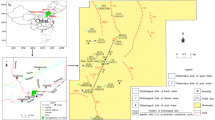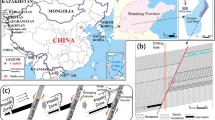Abstract
The deep Liuzhuang coal mine faces a risk of water-inrush from multi-layer Carboniferous and Ordovician karst aquifers below the coal floor. We analyzed the permeability of a major fault by in-situ water injection tests and found that its overall permeability was low. The hydraulic conductivity of test sections ranged from 3 × 10–4 to 7 × 10–4 m·d−1, with a maximum injection pressure of 1 Mpa. An analytical model of fluid–solid interaction was used to express the influence of mean principal stress and pore pressure on rock permeability, and a 3D numerical model of a pseudo-inclined working face was built to analyze the inrush risk of minor fault zones with varied occurrences and locations. The simulations showed that the risk of a delayed water inrush through the fault zones after fault exposure was greater than that of an instantaneous inrush. The risk of an inrush through the fault zone was greater near the middle of the working face than near the upper roadway; the risk of an inrush through the fault zone near the lower roadway was relatively small.
Zusammenfassung
Das tiefe Liuzhuang-Kohlebergwerk ist mit dem Risiko eines Wassereinbruchs aus mehreren Karst-Aquiferen in Karbon und Ordovizium im Liegenden der Kohlesohle konfrontiert. Wir analysierten die Durchlässigkeit einer Hauptverwerfung durch in-situ Wasserinjektionstests und stellten fest, dass ihre Gesamtdurchlässigkeit gering war. Die hydraulische Leitfähigkeit der Testabschnitte reichte von 3×10-4 - 7×10-4 m.d-1, bei einem maximalen Injektionsdruck von 1 Mpa. Ein analytisches Modell der Fluid-Feststoff-Wechselwirkung wurde verwendet, um den Einfluss der mittleren Hauptspannung und des Porendrucks auf die Gesteinsdurchlässigkeit auszudrücken, und ein numerisches 3D-Modell einer pseudo-geneigten Ortsbrust wurde erstellt, um das Einbruchsrisiko von kleineren Störungszonen an unterschiedlichen Orten und Dichte zu analysieren. Die Simulationen zeigten, dass das Risiko eines verzögerten Wassereinbruchs durch die Verwerfungszonen nach der Freilegung der Störung größer war als das eines sofortigen Einbruchs. Das Risiko eines Einbruchs durch die Störungszone war in der Nähe der Mitte der Abbaufront größer als in der Nähe des oberen Zugangstollens; das Risiko eines Wassereinbruchs durch die Störungszone in der Nähe des unteren Stollens war relativ gering.
抽象的
深部的刘庄煤矿面临着煤层底板石炭系和奥陶系岩溶含水层组突水的风险。利用原位注水试验分析了主断层的渗透性, 发现主断层的整体渗透性较低。试验段渗透系数在3 × 10–4—7 × 10–4 m-d−1之间, 最大注入压力1 Mpa。利用流-固作用解析模型表达了平均主应力和孔隙压力对岩石渗透性的影响, 建立了一个假倾斜工作面的三维数值模型, 分析了次断层带的发生和位置变化时的突水风险。模拟结果显示, 揭露断层之后, 断层带延迟突水风险大于瞬间突水。靠近工作面中部的断层带突水风险比接近上巷的断层带突水风险更大, 靠近下巷的断层带突水风险相对较小。
Resumen
La profunda mina de carbón de Liuzhuang se enfrenta a un riesgo de irrupción de agua procedente de los acuíferos kársticos de varias capas del Carbonífero y el Ordovícico situados bajo el suelo de carbón. Analizamos la permeabilidad de una falla importante mediante pruebas de inyección de agua in situ y descubrimos que su permeabilidad general era baja. La conductividad hidráulica de las secciones testeadas estuvo en el rango entre 3×10-4 - 7×10-4 m-d-1, con una presión de inyección máxima de 1 Mpa. Se utilizó un modelo analítico de interacción fluido-sólido para expresar la influencia de la tensión principal media y la presión de poros en la permeabilidad de la roca y se construyó un modelo numérico en 3D de una cara de trabajo pseudo-inclinada para analizar el riesgo de irrupción de zonas de fallas menores con ocurrencias y ubicaciones variadas. Las simulaciones mostraron que el riesgo de una irrupción de agua retardada a través de las zonas de falla después de la exposición de la falla era mayor que el de una irrupción instantánea. El riesgo de irrupción a través de la zona de falla era mayor cerca del centro de la cara de trabajo que cerca de la calzada superior; el riesgo de irrupción a través de la zona de falla cerca de la calzada inferior era relativamente pequeño.






Similar content being viewed by others
References
Angulo B, Morales T, Uriarte JA, Antigüedad I (2011) Hydraulic conductivity characterization of a karst recharge area using water injection tests and electrical resistivity logging. Eng Geol 117:90–96
Bai HB, Ma D, Chen Z (2013) Mechanical behavior of groundwater seepage in karst collapse pillars. Eng Geol 164:101–106
Barton N, Bandis S, Bakhtar K (1985) Strength, deformation and conductivity coupling of rock joints. Int J Rock Min Sci Geomech Abstr 22(3):121–140
Bear J (1972) Dynamics of fluids in porous media. Elsevier, New York City
Bense VF, Person MA (2006) Faults as conduit-barrier systems to fluid flow in siliciclastic sedimentary aquifers. Water Resour Res 42:1–18
Biot M (1941) General theory of three-dimensional consolidation. J Appl Phys 12(2):155–164
Bo MW, Arulrajah A, Leong M, Horpibulsuk S, Disfani MM (2014) Evaluating the in-situ hydraulic conductivity of soft soil under land reclamation fills with the BAT permeameter. Eng Geol 168:98–103
Bu WK, Mao XB (2009) Research on effect of fault dip on fault activation and water-inrush of coal floor. Chin J Rock Mech Eng 28(2):386–394 (in Chinese)
Cappa F, Rutqvist J (2011) Modeling of coupled deformation and permeability evolution during fault reactivation induced by deep underground injection of CO2. Int J Greenhouse Gas Con 5:336–346
Chen SY (2000) Control of sea-level change on coal accumulation in Carboniferous-Permian, north China. Coal Geol Expl 28(5):8–11 (in Chinese)
Chen ZH, Hu ZP, Li H, Chen QF (2011) Fracture mechanical model and criteria of insidious fault water-inrush through coal mines. J China Univ Min Tech 40(5):673–677 (in Chinese)
Fahimifar A, Zareifard MR (2009) A theoretical solution for analysis of tunnels below groundwater considering the hydraulic-mechanical coupling. Tunn Undergr Sp Tech 24:634–646. https://doi.org/10.1016/j.tust.2009.06.002
Hamm SY, Kim MS, Cheong JY, Kim JY, Son M, Kim TW (2007) Relationship between hydraulic conductivity and fracture properties estimated from packer tests and borehole data in a fractured granite. Eng Geol 92:73–87
Hu XY (2015) Study on mechanism of fault activation and water-inrush through insidious fault in mining floor. PhD Diss, China Univ of Mining Science and Technology (in Chinese)
Huang Z, Jiang ZQ, Zhu SY, Qian ZW, Cao DT (2014) Characterizing the hydraulic conductivity of rock formations between deep coal and aquifers using injection tests. Int J Rock Mech Min Sci 71:12–18
Huang Z, Zeng W, Zhao K (2019) Experimental investigation of the variations in hydraulic properties of a fault zone in western Shandong, China. J Hydrol 574:822–835
Huang QS (2018) Research on mechanism of water-inrush from floor in deep mining induced by the impact load due to roof collapse. PhD Diss, China Univ of Mining Science and Technology (Beijing) (in Chinese)
Indraratna B, Kumara C, Zhu SP, Sloan S (2014) Mathematical modeling and experimental verification of fluid flow through deformable rough rock joints. Int J Geomech. https://doi.org/10.1061/(ASCE)GM.1943-5622.0000413
Jones F (1975) A laboratory study of the effects of confining pressure on fracture flow and storage capacity in carbonate rocks. J Petrol Tech 27(1):21–27
Kitagawa Y, Fujimori K, Koizumi N (2007) Temporal change in permeability of the Nojima fault zone by repeated water injection experiments. Tectonophysics 443:183–192
Kranz RL, Frankel AD, Engelder T, Scholz CH (1979) The permeability of whole and jointed Barre granite. Int J Rock Min Sci Geomech Abstr 16(4):225–234
Levasseur S, Charlier R, Frieg B, Collin F (2010) Hydro-mechanical modelling of the excavation damaged zone around an underground excavation at Mont Terri Rock Laboratory. Int J Rock Mech Min 47(3):414–425
Li LJ, Qian MG, Yin YQ (1995) Research on the tests of water-inrush from floor simulated by similar materials. Coal Geol Expl 25(1):33–36 (in Chinese)
Li LJ, Qian MG, Li SG (1996) Mechanism of water-inrush through fault. J China Coal Soc 21(2):119–123 (in Chinese)
Li XZ, Zhang GY, Luo GY (2003) Barrier effects caused by fault on excavating-induced stress and deformation and mechanism of resulting groundwater-inrush. Rock Soil Mech 24(2):220–224 (in Chinese)
Li LC, Tang CA, Li G, Yang TH (2009) Damage evolution and delayed groundwater-inrush from micro faults in coal seam floor. Chin J Geotech Eng 31(12):1838–1844 (in Chinese)
Li WP, Liu QM, Sun RH (2011) Theoretical and experiment study on vadose conversion of water-inrush later occurred from structure broken zone. Coal Sci Tech 39(11):10–13 (in Chinese)
Li T, Mei TT, Sun XH, Lv YG, Sheng JQ, Cai M (2013) A study on a water-inrush incident at Laohutai coalmine. Int J Rock Mech Min Sci 59(5):151–159
Liu HL (2011) Study on hydraulic fracturing mechanism of rock mass and its application of outburst in mine. PhD Diss, Northeastern Univ
Louis C. Rock Hydraulics in Rock Mechanics (1974) Springer, New York City
Lu YL, Elsworth D, Wang LG (2013) Microcrack-based coupled damage and flow modeling of fracturing evolution in permeable brittle rocks. Comp Geotech 49(4):226–244
Lugeon M (1933) Barrages et Géologie. Dunot, Paris
National development and reform commission (2005) Code for water pressure test in borehole for hydropower and water resources engineering. China Electric Power Press, Beijing (in Chinese)
Nelson R (1976) Fracture permeability in porous reservoirs: an experimental and field approach. Int J Rock Min Sci Geomech Abstr 13(8):A86
Odintsev VN, Miletenko NA (2015) Water inrush in mines as a consequence of spontaneous hydrofracture. J Min Sci 51:423–434
Quinn PM, Cherry JA, Parker BL (2011) Quantification of non-Darcian flow observed during packer testing in fractured sedimentary rock. Water Resour Res 47:W09533. https://doi.org/10.1029/2010WR009681
Saunders WB, Ramsbottom WHC (1986) The mid-Carboniferous eustatic event. Geology 14(3):208–212
Tang CA, Tham LG, Lee PK, Yang TH, Li LC (2002) Coupled analysis of flow, stress and damage (FSD) in rock failure. Int J Rock Mech Min Sci 39(4):477–489
Vaskou P, de Quadros EF, Kanji MA, Johnson T, Ekmekci M (2019) ISRM suggested method for the Lugeon Test. Rock Mech Rock Eng 52:4155–4174. https://doi.org/10.1007/s00603-019-01954-x
Wang DC, Zhang RQ, Shi YH, Xu SZ, Yu QC, Liang X (2005) Fundamentals of Hydrogeology. Geology Press, Beijing (in Chinese)
Wu Q (2014) Progress, problems and prospects of prevention and control technology of mine water and reutilization in China. J China Coal Soc 39(5):795–805 (in Chinese)
Wu Q, Wang MY, Wu X (2004) Investigations of groundwater bursting into coal mine seam floors from fault zones. Int J Rock Mech Min Sci 41(4):557–571
Wu Q, Zhu B, Liu SQ (2011) Flow-solid coupling simulation method analysis and time identification of lagging water-inrush near mine fault belt. Chin J Rock Mech Eng 30(1):93–104 (in Chinese)
Xie HP, Zhou HW, Xue DJ, Wang HW, Zhang R, Gao F (2012) Research and consideration on deep coal mining and critical mining depth. J China Coal Soc 37(4):535–542 (in Chinese)
Xu ZM (2010) Mining-induced floor failure and the model, precursor and prevention of confined water-inrush with high pressure in deep mining. PhD Diss, China Univ of Mining Science and Technology (in Chinese)
Zhang PF, Shao LY, Dai SF (2001) Discussions on the transgression model of the late Paleozoic in the north China Platform. J Palaeogeograph 3(1):15–25
Zhang J, Wu Q, Mu WP, Du YZ, Tu K (2019) Integrating the hierarchy-variable-weight model with collaboration-competition theory for assessing coal floor water-inrush risk. Environ Earth Sci 78:205
Zhang FD (2016) Study on deformation failure mechanism of deep coal seam floor and evaluation method of water-inrush mining above confined aquifer. PhD Diss, China Univ of Mining Science and Technology, Beijing (in Chinese)
Zhao JH, Zhang XG, Ning J, Yin LM, Guo WJ (2020) Porosity zoning characteristics of fault floor under fluid-solid coupling. Bull Eng Geol Environ 79:2529–2541
Zimmerman RW, Bodvarsson GS (1996) Hydraulic conductivity of rock fissures. Transport Porous Med 23(1):1–30
Acknowledgements
The authors are grateful to all the people who contributed to the research, especially all of the coal mine staff who actively cooperated during the surveys. Thanks also to the editors and anonymous reviewers whose comments improved the scientific quality of the paper. This research was financially supported by the Natural Science Foundation of China (Grants 41807195, 41877186, and 41602262) and the China Postdoctoral Science Foundation (Grants 2019M661053, 2020T130390).
Author information
Authors and Affiliations
Corresponding author
Supplementary Information
Below is the link to the electronic supplementary material.
Rights and permissions
About this article
Cite this article
Zhang, J., Guo, L., Mu, W. et al. Water-inrush Risk through Fault Zones with Multiple Karst Aquifers Underlying the Coal Floor: A Case Study in the Liuzhuang Coal Mine, Southern China. Mine Water Environ 40, 1037–1047 (2021). https://doi.org/10.1007/s10230-021-00799-7
Received:
Accepted:
Published:
Issue Date:
DOI: https://doi.org/10.1007/s10230-021-00799-7




